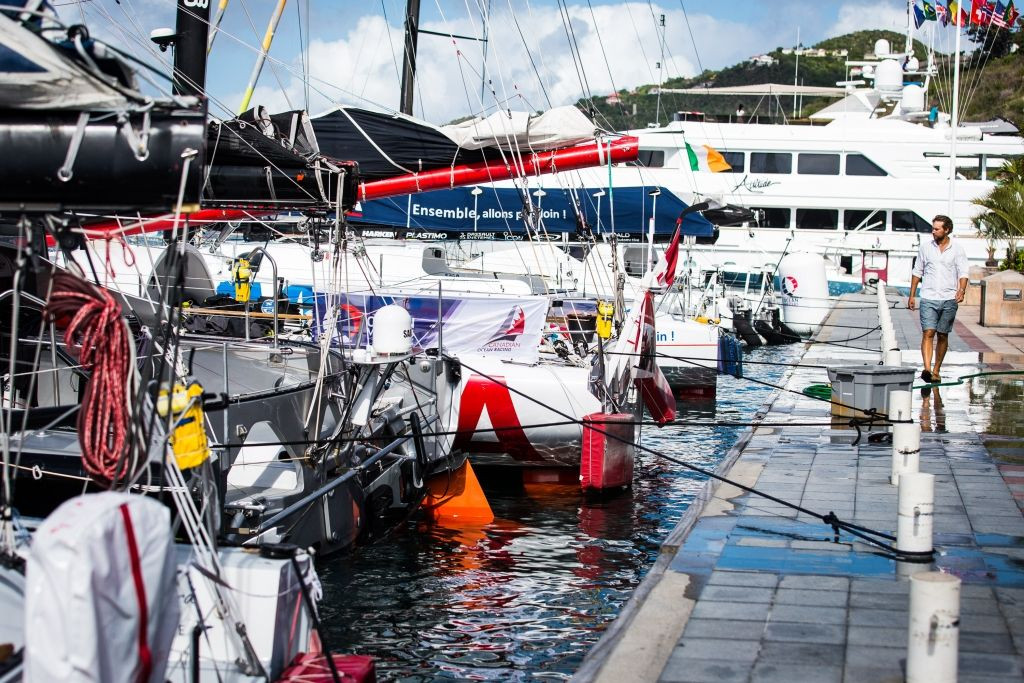Ready, set…

It is at 11:00am local time (or 15:00 GMT) tomorrow that the seven competitors will set sail from St Barths bound for Port-la-Forêt in Brittany. For the majority of the skippers, the excitement of the start is likely to be mingled with a thoroughly justified apprehension at the prospect of traversing the Atlantic singlehanded for the first time. The start of a transatlantic race requires careful planning, whether it’s by the racers, the préparateurs or the Race Management.
The racers:
For the sailors, it’s a question of not letting the pressure get the better of them. To achieve this, everyone has their little tricks, their routines: for some it will involve a checklist, to note that the bulk of the tasks have been completed, for others it will be about escaping into physical activity: jogging, swimming, anything that may help to stay in shape is also a fantastic way of decompressing. Consulting the grib files in a bid to anticipate the optimum route is also an excellent way to get in the zone. Switching from stand-by mode to race mode is also a learning process.
The préparateurs:
Their job will be complete once the boat casts off from the port of Gustavia. Up until that moment, they’ll constantly be ready for action, meticulous to the very end, on the search for the slightest detail, the slightest blip, which could bring the fine machine to a grinding halt. For them, the lounging Caribbean vibe is an illusion: whatever the temperature, they are hard at it inside the carbon hulls, which soon resemble a furnace, climbing to the masthead one more time to check that everything is as it should be, diving beneath the hull to track down the slightest hint of a rough edge, which could prevent the hull from slipping cleanly through the water. St Barths is unquestionably the dream holiday location… except for the préparateurs.
The Race Management:
They are the event’s conductors. It’s down to them to melodise the race start and try to anticipate the next ten days of racing: “The start phase itself is always tricky. However much the guys want to be prudent, the competitive spirit soon gets the upper hand and that’s where there is the greatest risk of collision with another boat. This is why we’ll set a start line around 300m offshore, without a specific coastal course. The aim is to make the racers’ lives as simple as possible: manœuvring an IMOCA60 singlehanded is already sufficiently complicated. After that, things should become easier: in principle, the fleet is likely to launch into a long beat on starboard tack in the tradewinds to pick their way northwards as far as the latitude of Miami, or even a little further north, before hanging a right. Next, the pace should pick up as the sailors latch onto the prevailing westerlies. For now, there is no rough weather forecast… but in winter situations can quickly evolve. Vigilance is imperative.”
Last minute: Yann Eliès withdraws
He had planned to be at the start of the Transat Saint-Barth / Port-la-Forêt. Despite being a competitor through and through, Yann has decided to withdraw from the competition in liaison with his shore crew. Facing structural issues, the skipper of Quéguiner / Leucémie Espoir deemed it unreasonable to attempt a solo transatlantic race in the depths of winter. “It is not a decision taken by the heart, but rather one dictated by reason!”
Teams info
Pip Hare's perspective on The Transat CIC
IMOCA skippers who are not participating in The Transat CIC are like us, glued to the map and race updates to analyze and understand the performances of their peers in the class.
•••IMOCA Race Report #2 I The Transat CIC - Day 6
At the halfway point, Conrad Colman, skipper of the IMOCA MS Amlin, gives us an update on what's happening at sea. Strategy, weather forecasts, conditions on board... you'll know it all!
•••